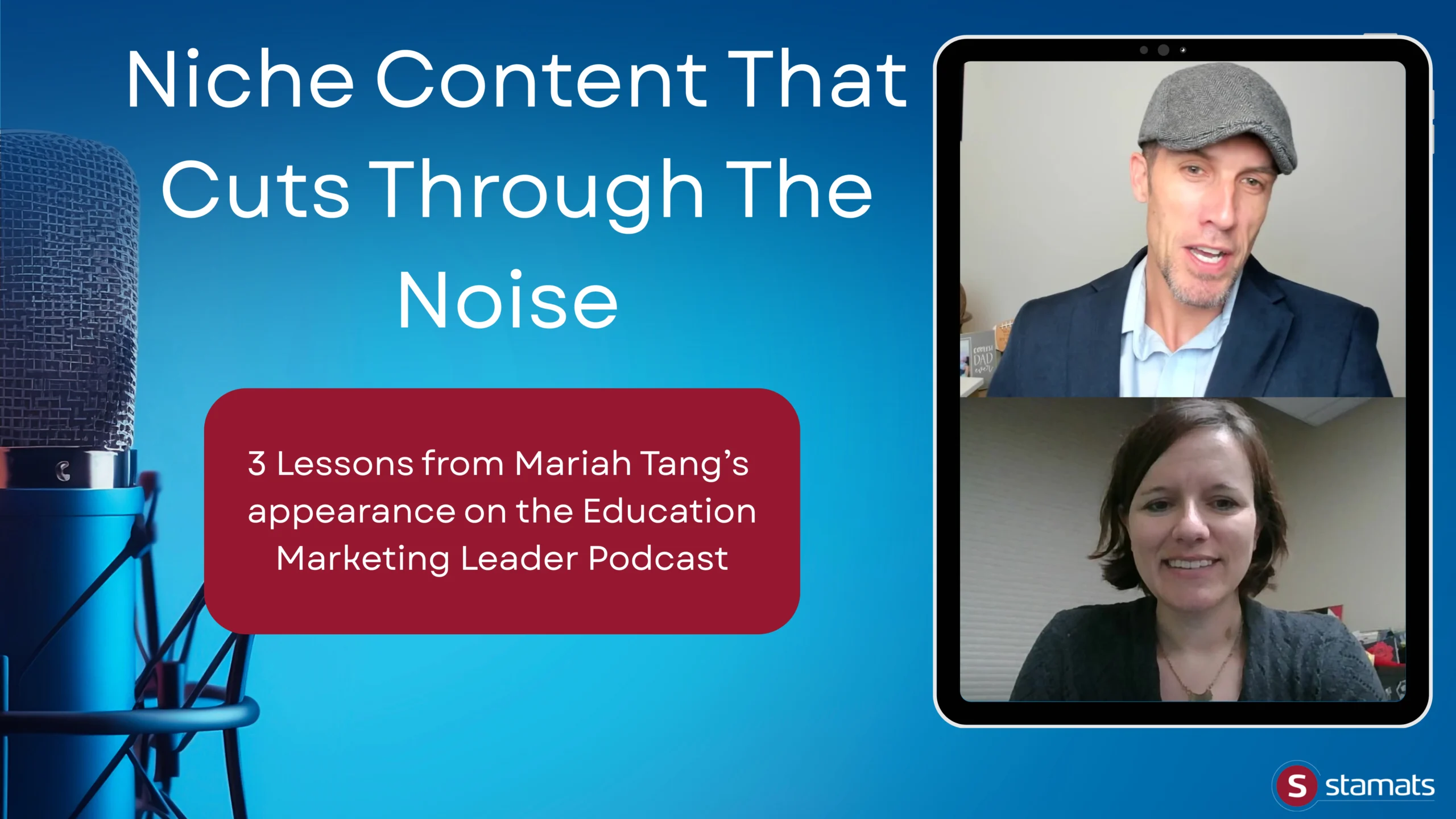
Christopher Lott
June 6, 2025

Like him or not, Joe Rogan has developed a massive following by mastering the art of niche content. Stamats’ Chief Content Officer Mariah Tang has noticed, and she’s helping clients leverage these principles to engage audiences and drive results.
Following a well-received webinar titled “The Joe Rogan Effect,” Mariah appeared on The Education Marketing Leader, a popular podcast hosted by Chris Rapozo, Stamats’ new AVP of Marketing Strategy.
“We’re living in a time when anybody with a microphone and an opinion can spread it around,” she said. “Higher education institutions and academic centers have an opportunity, maybe even a responsibility, to counter misinformation with real, evidence-based facts that give people a chance to make good decisions.”
At its core, niche content marketing means creating content that speaks to your expertise in a targeted way to appeal to a smaller segment of your total audience. By demonstrating your brand’s deep knowledge of a particular subject matter, you can engage audiences by answering their specific questions, sometimes even before they’ve thought about asking.
For example, a community college with a well-regarded program in automotive repair could consider creating content that speaks the language of students seeking education in the field.
Articles, videos, and other content that demonstrates the value of the program and how it fits into students’ busy lives could drive up applications for this strong program, expanding revenue for the college.
Consider the just a few benefits of building your content marketing strategy around your brand’s specific expertise:
In a wide-ranging interview, Mariah and Chris discussed how institutions like colleges, universities, and academic medical centers can harness the power of niche content to deepen brand engagement and nail their marketing goals. Here are a few actionable highlights from their conversation.
Listen to the full episode: Mariah Tang on The Education Marketing Leader
As clickless search takes hold across platforms like Google, Bing, and AI-based GPTs, the brands that rise to the top will be those that can leverage long-form content to speak to a niche audience.
“We’re going to see fewer broad searches and a lot more specific questions and specific conversation-based searched,” Mariah said. “I strongly believe this is why long form content—whether that’s video, blogs, or transcripts—will continue to have a place.”
Rather than trying to answer every question an audience member might have, brands can build knowledge centers that include several pieces of content to answer the most burning questions. In higher education, that might mean a range of queries, from “do you have my major?” to “how does your institution help me get the next step after my degree?”
“That really increases the chance your brand will surface in AI and Google searches, and whatever the next iteration is, too,” Mariah said. “It shows you’re in touch with your audience, you know what they’re looking for, and you have solutions at every stage.”
Related reading: The Joe Rogan Effect: Why Niche Content is Key to SEO Success
So how do institutions get all the expertise of their faculty into a niche content format that can engage audiences?
“It really starts with those experts,” Mariah explained. “Take their excitement, their enthusiasm, and their comfort level as your starting point.”
For academic institutions, the faculty are at the core of the student experience, and students want to know they’re learning from teachers who have experience and compassion. Lean into the personalities of these champions and build flexible content based on other sources like student testimonials. These first-person insights deliver trustworthy content that gets results.
As an example, Mariah cited Stamats’ work with the University of New Mexico Health Sciences Center, an academic medical center an Albuquerque, NM. They approached Stamats seeking to attract high-quality trainees to their neuroscience intensive care unit.
While interviewing UNM HSC’s in-house expert, Stamats’ team discovered an opportunity to target a niche with specific content rather than broad strokes. We asked the expert, what are trainees most worried about in a program like this? When they answered “work-life balance,” we knew we’d found a story to speak to the niche.
Stamats created a “day in the life” concept that included the program basics, as well as images, and details like “this is when you’ll sneak in a snack break.” It made the challenging program more digestible, and ensured prospective students understood the university is in their corner.
“They ended up winning a Digital Health Award for the story, and it continues to rank highly in search. That’s because it touches on both the facts and the emotional pull,” Mariah explained. “They continue to outrank institutions [in search results] that generally pull top candidates because they tapped into that emotional brand voice.”
Related reading: Search Is Changing: Shift Your Strategy & Tactics to Adapt
When you’re building a niche content empire, it’s important to think outside of your comfort zone. Many marketers are comfortable rolling out stats like student-to-faculty ratio and average class size. It can be difficult to remember those numbers don’t mean much to high school students choosing a college—or another path.
“There are a lot of alternatives to college,” Mariah said. “There’s a lot of different pathways to approach education. So, if you’re just going with hard facts or what people 10 years ago told you was important, you’re going to miss a lot of that.”
Answering the questions today’s students are asking is the key to building effective niche content. So how do you know what they need to know when even young alumni and current students can be out of date?
“Using tools like ChatGPT and Gemini can really help you collate what a lot of people are searching for in the moment, or at least in recent history,” Mariah advised.
Prompting an AI assistant to help you build prospective student personas can help dial in the specific questions your niche is asking.
“You can ask [AI] about their dreams, their concerns, their hopes—things that maybe people wouldn’t think to ask about or respond with if you were talking face to face,” Mariah explained.
The answers to those questions can lead to topics. These carefully crafted long-form content pieces on your website can inform the audience at any point in their decision-making process, helping them engage with your brand and understand how what you offer can help them achieve their goals.
These insightful tips are just the beginning of the wide-ranging conversation between Mariah and Chris on The Education Marketing Leader. For more, check out the full episode, and consider subscribing to the podcast for even more actionable advice.
If you’re ready to start building your institution’s niche content empire, Stamats can help.
Need help finding your niche? Let’s talk!